I was born in 1973 in Czechoslovakia. It was a small country in the middle of Europe, unfortunately on the dark side of the Iron Curtain. We had never been a part of Soviet Union (as many think), but we were so-called “Soviet Satellite”, side by side with Poland, Hungary, and East Germany.
My hobbies were electronics and – in the middle of 80s – computers. The history of computers behind the Iron Curtain is very interesting, with a lot of unusual moments. For example – communists at first called cybernetics as “bourgeois’ pseudoscience” (as well as sociology or semiotics), “used to enslave a mankind by machines”. But later on they understood the importance of computers, primarily for science and army. So in 50s the Eastern Bloc started to build its own computers, separately and “in its own way.”
The biggest problem was a lack of modern technologies. There were a lot of skilled and clever people in eastern countries, but they had a lot of problems with the elementary technical things. Manufacturing of electronics parts was divided into diverse countries of Comecon – The Council for Mutual Economic Assistance. In reality, it led to an absurd situation: You could buy the eastern copy of Z80 (made in Eastern Germany as U880D), but you couldn’t buy 74LS00 at the same time. Yes, a lot of manufacturers made it, but “it is out of stock now; try to ask next year”. So “make a computer” meant 50 percent of electronics skills and 50 percent of unofficial social network and knowledge like “I know a guy who knows a guy and his neighbor works in a factory, where they maybe have a material for PCBs” at those times.
We can talk a lot about Czechoslovak computers, for example the SAPO computer (7000 relays and 400 vacuum tubes, 1958) or Epos 2 (1968, diodes and transistors). Later on Comecon decided to build clones – better said “unlicensed pirate copies” – of western computers, namely IBM-360 or DEC PDP-11. In 1974 Comecon came with another strategy: build a line of small computers.
Just for context: at those times the CoCom embargo denied the export of modern technology to the Soviet bloc, for example modern CPUs (e.g. 68000). But eastern manufacturers made their own copies, based on reverse engineering, espionage and datasheets. Czechoslovak IC manufacturer Tesla made 8080 clone MHB8080 and copy of Intel 3000, a Germany supplier made 8008 and Z80 clones (U808D and U880D), Soviets produced 8080 and 8086 clones, Bulgarian plants made, for example, floppy disk mechanics etc.
I have to apologize to all other post-Comecon countries. They had their own home computer scenes, but I don’t know details about their computers etc. But we can say each country behind the Iron Curtain made its own home computers in 80’s. It was half on half “own design” and “clone of a western computer”. For example, Bulgarians had “Pravetz” computers, compatible with Apple II (but one type was compatible with Oric-1).
 In Czechoslovakia, there was the major electronics factory named Tesla. Its name should be an abbreviation of “Technika Slaboprouda” (“Low Voltage Technology” in English), but I guess it obviously referred to [Nicola Tesla]. It was formed as a holding of diverse electronics-related plants. One Tesla made semiconductors, another one made TVs, yet another produced record player chassis. It was a little bit of competition in the world of “total cooperative” (I remember they taught us that “competition is bad” in basic school, because “workers should cooperate in developing of socialism, neither compete nor rival”).
In Czechoslovakia, there was the major electronics factory named Tesla. Its name should be an abbreviation of “Technika Slaboprouda” (“Low Voltage Technology” in English), but I guess it obviously referred to [Nicola Tesla]. It was formed as a holding of diverse electronics-related plants. One Tesla made semiconductors, another one made TVs, yet another produced record player chassis. It was a little bit of competition in the world of “total cooperative” (I remember they taught us that “competition is bad” in basic school, because “workers should cooperate in developing of socialism, neither compete nor rival”).
One of Czechoslovak computer prodigies, [Eduard Smutný], together with his twin brother [Tomáš] designed the industrial computer JPR-12, based on Israeli ELBIT, and pushed it into production in Tesla. Some years later they made JPR-1, the simple 8bit computer, based on 8080. One important moment about this computer was that these designers published complete schematics and PCBs in Czechoslovak hobby magazine “Amatérské Rádio”. It was curious – you could not buy parts like LEDs in a store, but there was a very strong hobbyist’s scene. These people made radio transmitters or home automation or HiFi amplifiers. The communist regime surprisingly supported them (or better say: don’t repressed them) in their activities, because it felt the economy needed technically skilled people.
The JPR-1 was a single board computer with 8080 and its support chips (8224 and 8228) and some memory on a board. [Smutný] also designed other boards, for example alphanumeric TV display, port board, memory board, membrane keyboard, serial ports etc. Tesla made a whole line of these boards as an industrial computer, named SAPI. [Smutný] also made a Z80-based equivalent JPR-1Z, because (as he said) JPR-1 could work as CP/M machine, but Turbo Pascal needed Z80 instructions.
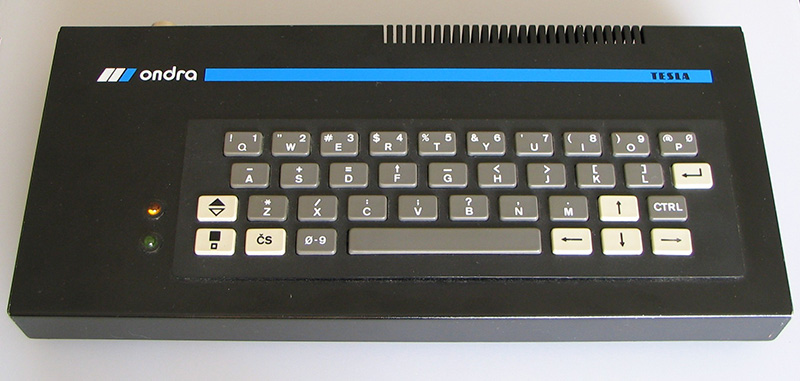
His last computer was “Ondra” (1986) – simple Z80-based computer with 64kB of RAM, built on single board, embedded in single case with the keyboard. Author says it was inspired by Sinclair’s ZX-81, but he couldn’t rely on ULA or similar custom VLSI, so he designed all these functions like RAM refresh or display timing as very clever hardware hacks, based on 8253 timers / counters and other parts, available in Comecon. Tesla made just about 1000 pieces of this computer, the majority of them was used in clubs of youth electronics.
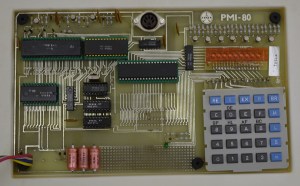
Other Tesla computers were designed by Slovak engineer [Roman Kišš]. The first one, PMI-80, was a classic Single Board Computer, like e.g. well known KIM-1. PMI-80 has 8080 equivalent MHB8080, 1 kB RAM, 8255 PIO (you can add second PIO and expand the port lines), calculator keyboard (5×5 matrix) and calculator LED display (9 positions). Its monitor takes 1kB of ROM. Users can connect some hardware to control and store the programs on cassette tape (all controlled by software, no special IC). PMI-80 was widely used as a school computer or as a simple industrial computer.
The second computer, designed by [Kišš] , was PMD 85. The “85” doesn’t refer to Intel 8085. Kišš says he was inspired by Hewlett-Packard’s computer HP-85. PMD 85 has 32kB of user RAM, 16kB of video RAM, 4kB of Monitor ROM and it was based on 8080A. PMD 85 came with EPROM module with built BASIC G. G is for Graphic – and PMD 85 was the first Czechoslovak 8bit computer with fine graphic mode 288 x 256 pixels (Black and White).
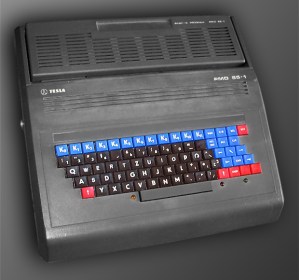
PMD-85 became quite popular. It had his drawbacks; sockets for some IOs weren’t precise and some IO could sometimes overheat. On the other hand, it was really the best Czechoslovak computer of the time. Tesla made some successors, named PMD 85-2, PMD 85-2A and PMD 85-3, with better keyboard, more memory, color display or ALL RAM mode. Czech fans made a lot of games and utilities for PMD, as well as hardware add-ons, from industrial printer interface to a joystick interface. PMD still has a strong community in both Czech and Slovak Republic till today and you can buy or build for example floppy disk drive or MIF-85 – a sound interface based on SAA1099.
PMD has some clones, namely Maťo, Zbrojováček or Didaktik Alfa, manufactured not by Tesla, but by a co-op, a school supplier, or the arms manufacturer Zbrojovka Brno.
If PMD-85 was the most beloved computer, its cousin, the IQ-151 was the widely hated one. It was designed by Czech company ZPA, a research plant focused on industrial automation. IQ-151 was a very big and heavy computer. It contains “mainboard” with 8080 CPU and some support parts, dock for expansion module and the infamous power supply which overheated, but it couldn’t provide enough power for more than two modules. If you wanted to work you have to connect at least a display module and a BASIC module. It was really a horrible computer. Poorly designed, poorly manufactured, with terrible keyboard seemingly based on a doorbell. The manufacturer made some necessary changes later on, but users disliked IQ-151.
The IQ-151 was planned as a school computer and some schools actually got it. At the dawn of the Eastern Bloc, the IQ-151 was upgraded to work in a local area network, with some kind of CP/M. The Mathematics and Physics department at the Charles University in Prague developed their own operating system, AMOS, and a Pascal compiler.
Let me say a little remark about “home computers”. Ondra or PMD-85 were home computers as we understand this term now: single case with keyboard, cassette tape as storage and TV for video out. But “home” is strongly misleading in the conjunction with Czechoslovak computers. The price of these computers was really fantastic – six month average salary or so, so the majority of production was bought by schools, clubs, industrial plants or research institutes. Technically, there were home computers, but almost nobody had these computers really at home as own, personal computer.
So the question is: What did we have in our households as our real home computer? Simple answer is: Everything we could smuggle from Western Germany, Austria or Britain. The most popular brands were Sinclair and Atari. You could buy, unofficially, of course, Sinclair ZX Spectrum and Atari 800 XL at prices about one month salary. Sometimes some official importer went mad and bought 1000 pieces of Sharp MZ-821 and sold them on the local market. The same situation was with Sord m5 – there were about 1000 m5s in Czechoslovakia. At the end of 80s some Amigas or Atari STs appeared in Czechoslovakia, but again individually imported.
But none of these importers ever imported any literature, manuals, just anything, so Czechoslovak computer fans were “hackers with a reason”. Total lack of information made us find fragments of knowledge almost everywhere. In hobby magazines, bad photocopies of foreign catalogs, books, foreign magazines. My friend, for example, had only an Atari 800XL, a list of instruction names for 6502 and disassembler software, so he reconstructed the whole instruction code table and meaning of codes by trial and error. I rewrote his remarks and “discoveries” on my typewriter in three exemplars, sent them to club newsletter.
Needless to say there was not only the official electronics and radio magazine Amatérské Rádio, but some computer clubs issued their own magazines too. They were published at varying levels of quality, from four papers joined by paperclip to professional brochures, issued in series of tens or hundreds copies. Members of these clubs shared their knowledge, lent documentation and made copies of software, from cassette to cassette, free of charge. Yes, it was breaking the copyright, and it was everywhere – from hobbyists to big corporations.

There was two strong scenes: one around Sinclair/Spectrum, and one around Atari, both with thousands of owners. Some people had Commodore C64, some Sord, Sharp MZ or Amstrad CPC, with tens or hundreds owners of each type. But there was rare computers too. For example, my friend’s father on his business trip “to the West” bought a Laser 210, which was rare computer here. It was very expensive, so he did not buy any software or something more. My friend then had a computer with literally no software or knowledge, he had a User Manual only, and he couldn’t find anyone with the same computer to share info or software.
Talking about software – the situation was even more ridiculous! Try to guess – how many software titles for home computers could you buy in Czechoslovak software shops in 1987? No, it wasn’t 1000. Not even 500. Neither 100 nor 50… No, not 10. The correct answer is: You couldn’t buy software in a shop! There were no shops with software or computer games. It was smuggled and copied from western countries. On the other side the lack of software meant that nearly every computer owner had to learn a little bit programming, at least in BASIC. There were a lot of skilled programmers who wrote games, compilers, and database programs. Another curiosity: when you wrote a software, it was illegal to sell it! That only became legal in 1988 and you still had to get an authority agreement.
To answer to the question “why Czechoslovak home computers uses primarily cassette tapes and not floppy disks?” Because you couldn’t simply buy a floppy disk at your local shop. There were five or ten better equipped shops in the whole country and they maybe had floppy disks. They got for example ten boxes of 5.25” floppies, sold out in one hour, and no more for two, three, six months… The only solution was smuggling, or black market. It got slightly better at the end of 80s.
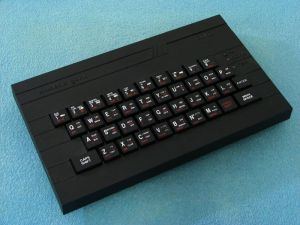
In 1987 manufacturer of school supplies Didaktik Skalica, maker of PMD clone Didaktik Alfa, made another computer named Didaktik Gama – a real clone of ZX Spectrum, extended with 8255 PIO and with RAM expanded to 80 kB. They bought a lot of original ULAs somewhere, so they built ZX Spectrum clone and started to sell it for a reasonable price. At the very end of 80’s we could buy this Czechoslovak computer at home for about one month salary.
This was the official part of Czechoslovak personal computers. We have to mention two local phenomena. The first one was a “capitalist enclave” – JZD Slušovice (JZD means ‘agricultural cooperative’). Its leader built a market oasis with a lot of economical exceptions, so they could buy ICs directly for foreign currencies, Dollars or Deutsche Marks. Therefore they made very sophisticated computers with contemporary design, for example based on Z80, with two floppy drives, RAM disk and CP/M. Oh, pardon, not CP/M, it was MIKROS or TNS-DOS – it was totally compatible with CP/M, but it was unlicensed. At the end of 80s they planned 16-bit computers compatible with PC, but then the Eastern Bloc collapsed and we could buy the original PC directly, mainly at the sales in neighbor countries like Austria or Germany.
The second phenomenon of these times was hobby computers. Mentioned earlier Amatérské Rádio published a lot of schematics and PCBs for different single board computers from Czechoslovak hobbyists. These computers had only one or very few exemplars. Amatérské Rádio itself published its own modular computer system Mikro-AR. But the most weird design I can remember was Mistrum computer – it was compatible with ZX Spectrum, but ULA was simulated by a bunch of chips from 74LSxx line. An unbelievable piece, a monument of an era in which people could develop computers, but couldn’t do it easy as “buy components and build”, the era of true hacking not for fun, but of necessity.
When the Eastern bloc fell down, we quickly filled the technological gap and started to use contemporary hardware, buy software (well… slowly) and adapt ourselves to standard computer economics (I worked with AT286 and laser printer in my first job in spring 1992). But you know – we sometimes reminisce our first computers…
Czechoslovak “home computers” from behind the Iron Curtain – or better say “Officially-made 8bit computers you could meet in 80’s”:
JPR-1 (SAPI-1):
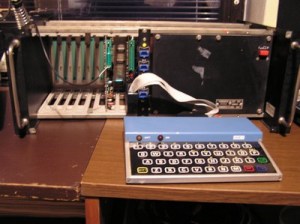 Multi board computer, based on 8080A, 1kB RAM, up to 8kB EPROM. Other boards added RAM, EPROM, TV display 20 lines x 40 characters, QWERTY membrane keyboard etc. Built-in MIKRO BASIC and monitor. Its primary aim was industry.
Multi board computer, based on 8080A, 1kB RAM, up to 8kB EPROM. Other boards added RAM, EPROM, TV display 20 lines x 40 characters, QWERTY membrane keyboard etc. Built-in MIKRO BASIC and monitor. Its primary aim was industry.
PMI-80:

Single board school CPU 8080A, 1.1111MHz (10MHz / 9), 1kB RAM, 1kB ROM, 25 key calculator type keyboard, 9 digit 7 segment LED display. Built-in monitor. Tape I/O. Created as didactic tool for technical schools.
PMD 85-1

CPU 8080A, 2.048MHz, 48kB RAM (later models with 56kB or 64kB), 4 kB ROM (later model with 8kB). Standard QWERTY keyboard, TV OUT 288×256 monochrome graphics, 25 lines, 48 chars. Last model can use 8 colors, first model just 4: black, white, grey and blinking). Tape deck as storage. 1bit beeper. Two parallel ports, serial port (8251). It uses ROM cartridges with BASIC (later you could buy Pascal too).
IQ-151:
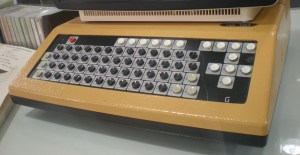 School computer, based on CPU 8080A, 2MHz, 32kB RAM (up to 64), 6kB EPROM (+ cartridges), 32 lines x 32 characters TV OUT (later 64 characters per line), you can add graphic monochrome module with 512×256 pixels resolution. Single bit speaker. 5 expansion slots, two of them were permanently taken by display adapter and BASIC. Very poor power supply, tends to overheat.
School computer, based on CPU 8080A, 2MHz, 32kB RAM (up to 64), 6kB EPROM (+ cartridges), 32 lines x 32 characters TV OUT (later 64 characters per line), you can add graphic monochrome module with 512×256 pixels resolution. Single bit speaker. 5 expansion slots, two of them were permanently taken by display adapter and BASIC. Very poor power supply, tends to overheat.
Tesla Ondra:
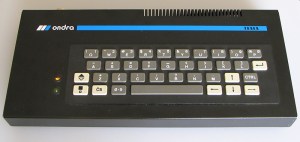
Very rare computer. CPU U880D (Z80 clone from GDR), 2MHz, 64kB RAM, 4kB ROM, TV display 20 lines x 40 chars, graphic mode 320 x 240 monochrome. QWERTY keyboard, tape interface. BASIC was on the tape and you had to load it before use.
Didaktik Gama:
 ZX Spectrum clone with original ULA (later models Didaktik M and Didaktik Kompakt from early 90’s use ULA1 from USSR, so the display was square shaped instead of rectangle and there were some timing incompatibilities). It was the first real home computer you could buy.
ZX Spectrum clone with original ULA (later models Didaktik M and Didaktik Kompakt from early 90’s use ULA1 from USSR, so the display was square shaped instead of rectangle and there were some timing incompatibilities). It was the first real home computer you could buy.
About the author
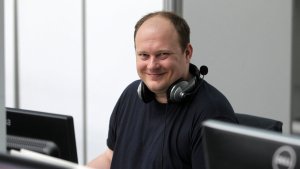 [Martin Malý] works as a media technology consultant and team leader of developers for some Czech newspapers. He has experience from startups and did a lot of web projects (e.g. was a Lead developer, Programmer, Administrator, Manager and Ideologist for a cutting edge Czech blogging system called Bloguje.cz).
[Martin Malý] works as a media technology consultant and team leader of developers for some Czech newspapers. He has experience from startups and did a lot of web projects (e.g. was a Lead developer, Programmer, Administrator, Manager and Ideologist for a cutting edge Czech blogging system called Bloguje.cz).
His biggest hobby, beside programming, is microelectronics and old computers. He did some task programming on railroad engines, based on microcontrollers (8051 family, AVR, Microchip) and some “homebrew” gadgets, computers etc. He joined his two hobbies together in ASM80.com – an online IDE and assembler for 8bit CPUs.
[Martin] is an Evangelist and Teacher of New Web Technologies (OpenID, OAuth, cloud computing, HTML5, Node.js, Coffeescript and other stuff) as well as Evangelist of HTML5 development for mobile devices.
He does quite a bit of writing – starting with some juvenile textperiments, continuing through a series of blogs and online magazines, and he ended up as an Editor-in-Chief of zdrojak.cz – an online mag about web technologies.

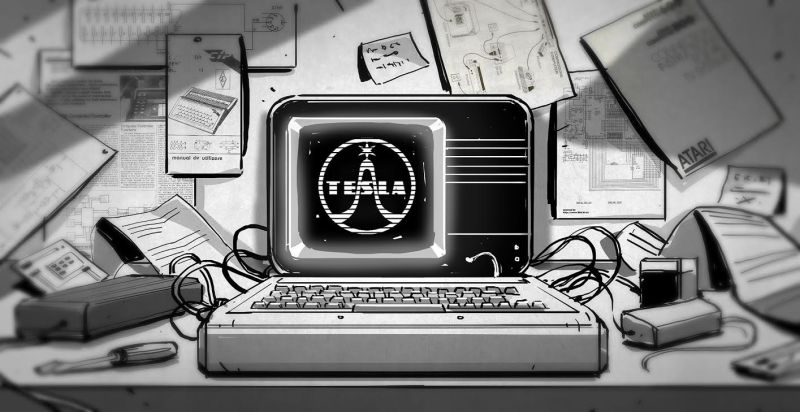















@Martin Malý: nice article – i remember this times – when i made my first computer – hand soldered a ZX spectum clone with Z80/UB880 – takes half of my summer school break whe i was 14 in east germany – when i was ready – i needed to start to write my apps my self by hand in BASIC. Still have KC85/2, ZX spetrum (clone and original), Amiga 2000 at home! still working – but not much time now – i switch them only sometimes on x-mas break to see if then still work!
Awesome post! I remember my Dad was Chief Engineer at the Tesla Radio Factory in Mumbai, India in the 50’s and he’d talk about all the stuff they were doing out there. Reading this refreshed a lot of those memories.
I accompanied my father, David Fraser, back in 1979 or there abouts to take part in a demonstration/lecture of a precursor of the ZX80. He was a computer scientist at Kings Collage in London.
The hardware looked VERY similar indeed to the PMI-80.
My “very important job”, (I was very young at the time), was to play “Three Blind Mice” on the hex keyboard. THe idea being to show that the computer was so simple to use that even a child could use it.
I like to think (rather wild imagination) that in some small way I contributed to the emergence of the modern computing world …
We had the VideoTon TV Computer in the second half of the 80s. https://en.wikipedia.org/wiki/Videoton_TV-Computer
It was an older design and much slower than the C64 yet due to licensig costs (it was legally licensed from Enterprise) it costed much more than a C64.